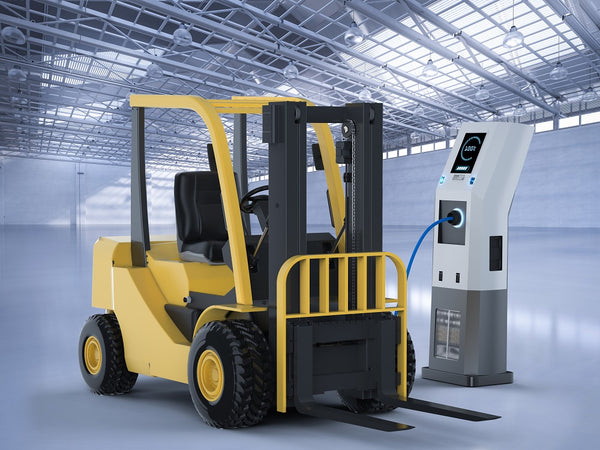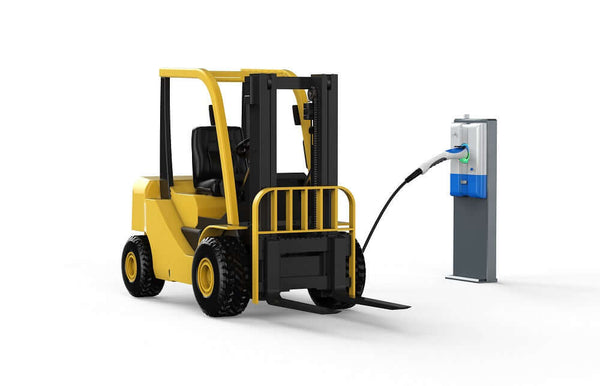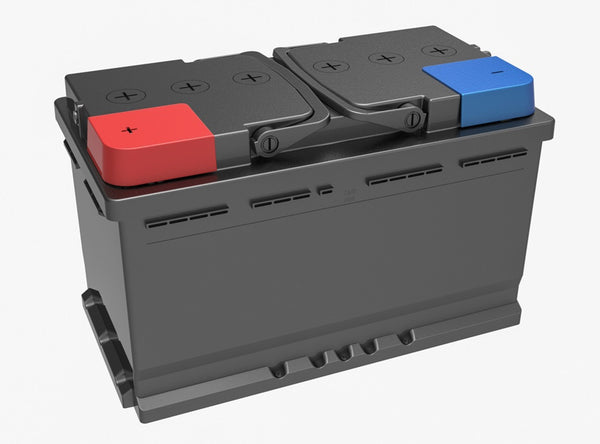Forklift batteries are used as DC power supplies for forklifts, tractors, trucks, underground mining locomotives and other equipment, and are widely used in airports, stations, ports, vegetable and fruit markets, industrial and mining enterprise warehouses and other places. Forklift battery refers to a battery dedicated to forklifts that uses batteries for work. This is the battery in the battery of an electric forklift. The accumulator is a kind of battery, and its function is to store the limited electric energy and use it in a suitable place. Its working principle is to convert chemical energy into electrical energy. It should be noted that the battery is best not to be placed horizontally! Because the inside of the battery is generally 22-28% dilute sulfuric acid. When the battery is being placed, the electrolyte can flood the electrode plates and there is still a little space left. If the battery is placed horizontally, a part of the electrode plates will be exposed to the air, which is very detrimental to the electrode plates of the battery, and the observation hole of the general battery or There are vents on the top of the battery to communicate with the outside, so the battery's lateral discharge solution can easily flow out.

Structural characteristics
Use polyester fiber tube, with good elasticity, small hole diameter, low resistance, high air permeability; fully insulated flexible cable, no leakage current to open the valve structure of the top plug, with a special electrolyte level indicator; Equipped with a liquid injection cap for automatic water replenishment; imported high-quality oblique separators with multiple micropores, high porosity, low resistance, and PP battery shell and cover materials, which are impact resistant;

Battery type
1. Lead-acid batteries
Lead-acid batteries have a history of more than 100 years and are widely used as the starting power source for internal combustion engine vehicles.
2. Nickel-cadmium battery
The application range of nickel-cadmium batteries is second only to lead-acid batteries. Its specific energy can reach 55W·h/kg, and its specific power exceeds 190W/kg. It can be quickly charged and has a longer cycle life, which is more than twice that of lead-acid batteries. It can reach more than 2,000 times, but the price is 4-5 times that of lead-acid batteries.
3. Ni-MH battery
Like nickel-cadmium batteries, nickel-metal hydride batteries are also alkaline batteries. Their characteristics are similar to those of nickel-cadmium batteries. However, nickel-metal hydride batteries do not contain cadmium and copper, and there is no problem of heavy metal pollution.
4. Sodium-sulfur battery
Sodium-sulfur batteries are also popular electric vehicle batteries in the near future. Sodium-sulfur batteries mainly have serious high temperature corrosion and short battery life. Performance stability and safety of use are not ideal and other issues.
5. Zinc-air battery
The potential specific energy of the zinc-air battery is about 200w·h/kg. It still has shortcomings such as short life, low specific power, inability to output large currents, and difficulty in charging.
6. Flywheel battery
The flywheel battery is a new concept battery proposed in the 1990s. It breaks through the limitations of chemical batteries and uses physical methods to store energy.
7. Fuel cell
A fuel cell is a power generation device that directly converts the chemical energy stored in fuel and oxidant into electrical energy through electrode reactions. It does not undergo a thermal engine process and is not restricted by a thermal cycle, so the energy conversion efficiency is high.
performance
Long service life; superior cycle performance and deep discharge recovery ability; reliable sealing structure, no leakage in normal use; short-circuit-proof design, maximum prevention of battery short-circuit automatic water filling system and gas stirring system

Six points of maintenance
Six points for safe use and maintenance of forklift batteries
Daily inspection
1. Liquid level: lower than the rated liquid level, it will shorten the service life of the battery, and too little electrolyte will cause heat damage to the battery. Therefore, you must always pay attention to whether the electrolyte is sufficient.
2. Terminals, wires, and covers: Always check the junctions of the battery terminals and the connections with the wires for corrosion caused by oxidation, and check whether the cover is deformed and whether there is heat.
3. Appearance: Dirty surface of the battery will cause leakage. Keep the surface of the battery clean and dry at any time.
2. Maintenance
Charging precautions
1. Add water: add distilled water according to the specified liquid level. Do not add too much distilled water in order to extend the time between adding water. Adding too much water will cause the electrolyte to overflow and cause leakage.
2. Charging: During the charging process, the battery will produce gas. The charging place should be well ventilated and there is no open flame around. At the same time, the oxygen and acid gas generated during the charging process will affect the surroundings. When the charging plug is unplugged during charging, an arc will be generated. Turn off the charger before unplugging the plug. After charging, there is a lot of hydrogen staying around the battery. No open flame is allowed. The cover on the battery should be opened for charging.
3. Maintenance of terminal, wire and cover: it must be carried out by professional and technical personnel designated by the manufacturer.
4. Cleaning: If it is not too dirty, you can wipe it with a damp cloth. If it is very dirty, remove the battery from the car, rinse it with water and let it dry naturally.
custody
1. Storage place: It cannot be short-circuited; short-circuit caused by rain may cause a fire and may produce a small amount of hydrogen. Therefore, the battery must be stored in a ventilated, cool place.
2. Waste storage battery: The used storage battery still has electric energy and should be kept according to the storage method of the used storage battery.
Electrolyte operation
1. Check the specific gravity: use a suction hydrometer to check the specific gravity, do not let the electrolyte spill out during operation, and wear protective equipment.
2. Operations other than inspection: consult professionals, especially when replenishing electrolyte (dilute sulfuric acid).
3. Electrolyte leakage: due to the overturning or damage of the battery, the electrolyte leakage should be dealt with immediately (refer to emergency treatment items)
End of life operation method
1. Operation of the end-of-life battery: When the battery is approaching the end of its life, the electrolyte in the single cell will be reduced very quickly, and distilled water should be added every day.
2. Disposal of used batteries: For used batteries, draw out the electrolyte and decompose the batteries. It can be negotiated whether to be recycled by the battery manufacturer.
Emergency treatment
1. Electrolyte splashed on the skin: rinse with plenty of water
2. Electrolyte splashed into the eyes: rinse with plenty of water, and then receive treatment from a professional doctor
3. Electrolyte spilled on clothes: Take off clothes immediately, rinse with water and then rinse with weak alkaline soap.
4. Electrolyte leakage: When the electrolyte leaks to the outside, immediately neutralize it with lime, strong carbonated soda or carbonated soda, and rinse with plenty of water.
JUNLEE Group is an integrated full power energy factory that specializes in Uninterruptible Power Supply (UPS), Lead-Acid Battery, Battery pack, EV battery, Energy Storage Battery, Energy storage power station, Power pack Gel battery, PV Inverter and Solar system.
Production capacity reach 200000 KVaH per month. Products apply to Electric vehicles,electric mobility, solar & wind energy storage system, UPS, backup power, telecommunication, medical equipment and lighting.
JUNLEE sets up "Power research center" with more High-tech products.More than 100 engineers provided in-time and efficient one-stop solutions.
They mission strives to bring green power to the world.
To learn more about Li-ion batteries, please refer to https://www.junleepower.com/

